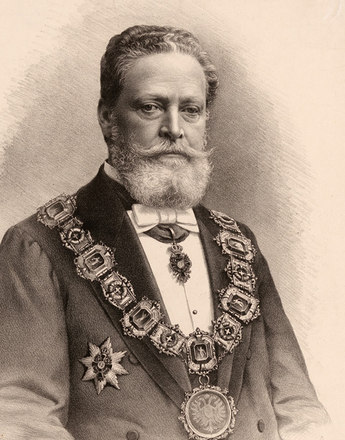The law on the national holiday was followed shortly afterwards by one on a new coat of arms for the state, and in 1920 a melody by Wilhelm Kienzl, with words by Karl Renner, ‘Deutschösterreich du herrliches Land’ (‘German-Austria, thou splendid land’), was chosen as the national anthem. In particular the story of the origin of the anthem shows how difficult it was to find even symbols for the new state that its citizens could identify with.
In addition to the national holiday and a new flag a new national anthem had also to be found, after the old melody by Haydn with its ever changing texts recalling the emperor and the monarchy had done its duty and had been sung for the last time – at least as the official national anthem – in Schönbrunn Palace on 10 November 1918. Even before then the Provisional National Assembly had been repeatedly disrupted by protesters singing certain songs, for example Die Wacht am Rhein (The Watch on the Rhine). After the state chancellery had received numerous proposals for a new national anthem, Chancellor Renner asked Wilhelm Kienzl, the composer of the opera Der Evangelimann (The Evangelist), to provide the music for words which Renner himself had written: ‘Deutsch-Österreich, du herrliches Land (‘German-Austria, thou splendid land’).What is remarkable is, apart from the fact that it was the chancellor himself who had penned the words, above all the name given to the state being addressed: after all, according to the peace treaty of Saint-Germain the word ‘German’ was no longer to be included. Renner had supposedly used the correct term ‘Republic of Austria’ in an earlier version of his anthem, so that the change can be seen as a protest or an act of defiance against the ban on union with Germany. The hymn begins by praising the beauties of the landscape, still today a feature which plays an important part in forming the national identity, then the hard fate of the strong and clever ‘long-suffering people’, and ends by calling on the people of the ‘land of the eastern Alps’ to hold together and to be prepared to fight. Critics found fault not only with the poor quality of the verse – the Christian Socialist Carl Vaugoin, subsequently vice-chancellor, called the piece an ‘occasional poem’ – but also with the march-like melody.
The anthem was first performed on the occasion of the swearing in of the new Austrian army on Heldenplatz square in Vienna in July 1920, but it was never given official status. As a result on various ceremonial occasions the old imperial anthem and the Deutschlandlied (‘Deutschland, Deutschland, über Alles’) could often also be heard. In 1929 a Cabinet resolution replaced it with a new national anthem known as the Österreichische Volkshymne. The text was provided by a poem by Ottokar Kernstock that had appeared in 1919; it ended with the words ‘God be with thee, my Austria’, while for the melody recourse was again made to Haydn’s popular anthem. After disagreement between the political parties, in 1930 the Ministry of Education under Heinrich Srbik issued a decree which stated:
On official occasions the only anthem that may be sung is the ‘Österreichische Volkshymne’. On occasions which are not in themselves official in character there has not been and naturally still is no objection to the singing of the ‘Deutschlandlied’, which has the same melody. The anthem by Renner and Kienzl, which has up to now been sung on official occasions and which has never been officially declared to be the national anthem, may not be used in future in an official context.
The Vienna Board of Education under Otto Glöckel announced:
The ‘Deutschlandlied’ to the melody of Haydn’s anthem represents the emotional as well as the official expression of the awareness of the unity of the entire German people. The Board of Education expects this song to be rehearsed in all schools and sung on the appropriate occasions in order to further the national and republican education of young people.
These statements also show yet again two characteristics of the political culture of the First Republic: on the one hand the divergent positions of the political camps on the symbols of state were issues to be discussed, while on the other the consistently Pan-German attitude of the Social Democrats was evident.
Translation: Leigh Bailey
Diem, Peter: Lieder und Hymnen, die Österreich bewegten. Unter: http://peter-diem.at/Lieder/Liedertafel.htm (20.6.2014)
Hanisch, Ernst: Politische Symbole und Gedächtnisorte, in: Tálos, Emmerich (Hrsg.): Handbuch des politischen Systems Österreichs. Erste Republik 1918-1933, Wien, 1995, 421-430
Welan, Manfried: Österreich und die Haydnhymne. Politische und kulturhistorische Betrachtungen, Wien 2009. Unter: http://www.boku.ac.at/wpr/wpr_dp/DP-44-2009.pdf (20.6.2014)
Tonaufnahme Hymne Deutsch-Österreich: http://www.mediathek.at/atom/135E603D-05A-00061-000004A4-135DCBB9 (20.6.2014)
Tonaufnahme Hymne "Sei gesegnet ohne Ende": http://www.mediathek.at/atom/135E8845-36E-002D4-000004A4-135DCBB9 (20.6.2014)
Quotes:
„On official occasions the only anthem ...": „Bundeshymne – Deutschlandlied” Ein neuer Erlaß des Unterrichtsministeriums, in: Wiener Neueste Nachrichten, 15.12.1930 (Translation)
-
Chapters
- 12 November 1918 as a Site of Memory
- The New State in Search of its National Holiday: 12 November as the Site of Political Dividing Lines
- Austria, the Country without a National Anthem
- Disputed Zones: Monuments and Street Names
- Myths and Narratives: ‘The Rest is Austria!’ … or something like that
- Myths and Narratives: ‘The Reluctant State’ and ‘The State that Nobody Wanted’
- No Role to Play and yet part of Austria’s Heritage: the Habsburgs after 1918







